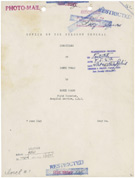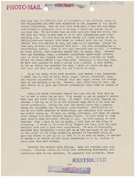Scenes From Hell
Marie Adams - Internment of American Civilians in the Philippines, 1945
The invasion of the Philippines came hours after the Japanese attack on Pearl Harbor on December 7, 1941. Thousands of American civilians living in the Philippines were captured and held in captivity by the Japanese until the end of World War II. As the war progressed, the internees found themselves living a nightmare of steadily deteriorating conditions inside the camps—struggling for food and other necessities of life over a three year period.
Santo Tomas University, in downtown Manila, was converted to an internment camp that held more than 4,000 civilians. Among them was Marie Adams, a Red Cross worker, approximately fifty years old, who was held there from May 1942 until the camp was liberated in February 1945. Throughout her confinement, she worked in the compound’s hospital, adapting to the increasing medical needs of the camp’s population, even as her own physical condition declined. Four months after the camp was liberated, she wrote a report describing the dire conditions in the camp and how she calmly calculated how to ensure the survival of the greatest number of the internees, as well as her own.
Marie Adamsís report on conditions at the Santo Tomas internment camp, June 7, 1945, cover page
In this report, Adams notes a drastic decline in the living conditions beginning in February 1944, when the administration of the camp shifted from Japanese civilian to Japanese military authority. From that point forward, she chronicles a desperate effort on the part of the internees to stave off starvation long enough to be rescued.
In the final pages of this report, Miss Adams concluded that, had the internees not been rescued in early February 1945, they would have died within three to four weeks. Based on her own level of activity—the work she was doing to care for others—she calculated that she would have been dead in four to five days. She weighed ninety-five pounds at the time the camp was liberated.
National Archives, Records of the Office of the Surgeon General (Army)
Excerpt:
“Irritability is one of the first symptoms of starvation, and certainly that symptom was marked among us. We were all cross, irritable, and edgy; we argued about things that were utterly insignificant. We were ready to claw each other’s eyes out—over nothing at all. We were hungry; we were starved. When I went to bed at night, I felt just on the verge of screaming. I ached to the ends of my fingers and toes, with the most horrible ache that I have ever experienced.”
—From Marie Adams’s report
.
Marie Adamsís report on conditions at the Santo Tomas internment camp, June 7, 1945, page 26
In this report, Adams notes a drastic decline in the living conditions beginning in February 1944, when the administration of the camp shifted from Japanese civilian to Japanese military authority. From that point forward, she chronicles a desperate effort on the part of the internees to stave off starvation long enough to be rescued.
In the final pages of this report, Miss Adams concluded that, had the internees not been rescued in early February 1945, they would have died within three to four weeks. Based on her own level of activity—the work she was doing to care for others—she calculated that she would have been dead in four to five days. She weighed ninety-five pounds at the time the camp was liberated.
National Archives, Records of the Office of the Surgeon General (Army)
Excerpt:
“We were so thoroughly depleted that frequently I would sit on my bed and stare at the sink in the corner of the room, wondering whether it was worth while to make the effort to get up and go over to it to wash my hands, or whether it wouldn’t be better to wait until lunch-time to do it, because it would save that much energy. . . .”
—From Marie Adams’s report
.
Shanties were built in a courtyard at Santo Tomas to help ease the overcrowding in the buildings, 1945
National Archives, Records of the Office of the Chief Signal Officer [111-SC-202141]
.
Photostats of Marie Adams, included in her official report, submitted 1945
These photostats show how she looked in 1941, prior to her departure for the Philippines, and in 1945, at the time of her liberation.
Miss Adams was awarded the Bronze Star Medal “for meritorious achievement while in the hands of the enemy in caring for the sick and wounded.”
National Archives, Records of the Office of the Surgeon General (Army)
.



